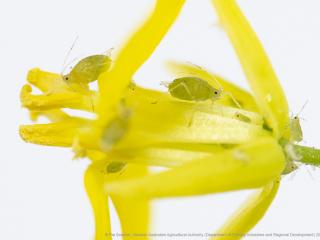Aphid activity and turnip yellows virus detections
- Kendenup
- South Stirling
- Mobrup
- Ongerup
- Gnowangerup
- Cranbrook
- Gibson
- Dalyup
- Condingup
Autumn and early winter is a crucial period of the growing season for early season green peach aphid (GPA) infestation and turnip yellows virus (TuYV) infection in canola.
As part of a DPIRD Boosting Grains Science Partnership surveillance project 88 yellow sticky traps were set up across 72 sites in the Albany and Esperance port zones from mid-March to mid-April.
Minimal aphid activity was detected. Low cabbage, green peach aphid (GPA) and turnip aphid numbers were caught at; Kendenup, South Stirling, Mobrup, Ongerup, Gnowangerup, Cranbrook, multiple sites around Gibson and Dalyup, plus Condingup
From these aphid populations TuYV was detected in GPA captured at Cranbrook, Kendenup and Mobrup.
DPIRD will continue to provide updates to growers and consultants throughout May and June as we collect data from our targeted sites in these regions.
The presence of volunteer canola and cruciferous weeds (particularly wild radish) in the grainbelt can give aphids a chance to build-up which can increase the risk of early incursion of TuYV if winged aphids transmit virus from infected weeds to vulnerable germinating canola crops.
Growers are urged to monitor their germinating canola for aphids and signs of symptomatic plants.
What is turnip yellows virus?
TuYV, formerly known as beet western yellows virus, is an obligate plant parasite transmitted by several aphid species that colonise canola including its principle vector, the GPA (Myzus persicae) and the minor vector, the cabbage aphid. For more information about these aphids refer to DPIRD’s Aphid management in canola crops page.
It causes yield and quality losses in canola crops. It also infects other crop and pasture species including mustard, chickpea, faba bean, field pea, lucerne, medic and subterranean clover.
Timing of infection is key with heavier losses more likely if infection occurs during the rosette phase of canola up until stem elongation (GS30).
TuYV systemically infects plants and cannot be sprayed-out post-infection like a fungal disease. Therefore, control of the virus needs to be focussed on prevention rather than cure.
Diagnosing and preventing turnip yellows virus
Signs of TuYV infection in the paddock include discoloured and stunted plants that occur in patches, in thinner crop areas or the edge of the paddock, and gradually spread.

TuYV infection causes reddening, purpling or yellowing of the lower leaves of canola plants. Plants infected early (well before flowering) are often pale and stunted and these plants produce few flowers or seeds. Symptoms are milder and stunting is lacking with late infection. Leaf symptom type and severity differ depending on plant age at infection, environmental conditions and the canola variety involved. Symptoms of TuYV in canola can be confused with those caused by nutrient deficiencies, waterlogging or other plant stresses that cause yellowing, reddening or purpling of lower leaves.
TuYV spread can be controlled by applying neonicotinoid seed dressings.
Foliar sprays can also be applied to reduce infected aphid numbers but GPA has evolved resistance to many insecticide chemicals. Effective chemicals currently available in Australia for control of GPA are alarmingly limited. Overreliance and misuse of one of the remaining insecticides, sulfoxaflor (Transform®), could be leading to reduced sensitivity in some Australian GPA populations. For more information see GRDC’s Aphid and insecticide resistance management in grain crops.
For more information on this work refer to DPIRD’s Turnip yellows virus early warning system page.
For insecticide recommendations, refer to DPIRD’s 2022 autumn winter insecticide guide.
Other management practices include; sowing into stubble and delayed sowing to avoid peak autumn aphid flights.
If you see aphids are colonising green bridge hosts, or you have symptomatic looking plants that you are concerned about, they can be tested for the presence of TuYV through the Department’s Diagnostic Laboratory Services – Pathology Services.
For more information refer to DPIRD’s Turnip yellows virus in canola: diagnosis and management page.
For further information contact Research scientist Benjamin Congdon, South Perth on +61 (0)8 9368 3499.
Article authors: Benjamin Congdon (DPIRD South Perth) and Cindy Webster (DPIRD Narrogin).

